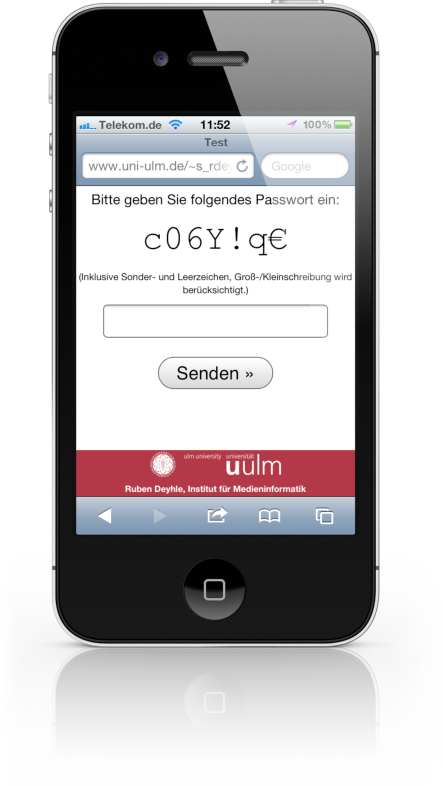Automatic Speech Dialog Generation from User Interfaces of Mobile Applications

Mobile devices, especially smartphones, provide the user with various information and are often regarded as a personal assistant. Obviously, the user wants to access the smartphone while driving a car, which is currently prohibited. An integration into a car's HMI overcomes this restriction. This work envisions a speech only control of smartphones within a car's application. Thereby, the GUI specification of the smartphone app is used to generate the grammar and lexicon for the speech dialog system. The transformation method regards characteristics of each modality and analyzes a GUI according to the mental model of each element and furthermore the elements' relation to each other. In addition, various phrases with the same meaning are generated to respect individual communication styles.
| Author: | Sven Reichel |
| Supervisors: | Michael Weber, Ute Ehrlich (Daimler AG) |
| Context: | Master thesis 2012 |
| Resources: | Video |
FiMS - Find My Stuff!

FiMS is a search engine for everyday objects based on a ZigBee mesh network, RFID and service-oriented server communication. It is not used to calculate a exact position, but a relative position according to landmarks in a room. For this reason, furniture pieces are part of the mesh network and got RFID readers. While every day objects are tagged with a ZigBee module and an RFID chip. Furthermore the system is designed to communicate with other systems at remote locations. This way search results can be extended to a much wider range.
| Team: | Pascal Knierim, Steffen Musiol, Jens Nickels |
| Advisers: | Bastian Könings, Florian Schaub, Björn Wiedersheim |
| Context: | Project Ubiquitous Computing 2011/12 |
| Resources: | Website Video Streiflicht talk |
Access Control Mechanisms on Head-Unit Operating Systems

Head-unit applications have attracted considerable attention for their promise of value-added services. The integration of head-unit applications rises new security and privacy challenges in automotive environments. Applications may access a large number of sensor data and collect a driver's usage information virtually at any time. At the same time, requirements of minimal driver distraction must be respected so that access decisions are made without interrupting the user. The thesis analyses access control mechanisms of well-established mobile operating systems, showing that these fall short of meeting automotive requirements. From there, the thesis develops a concept of an access control framework for head-unit applications that features context-sensitive and privacy-aware decision making.
| Author: | David Herges |
| Supervisors: | Michael Weber, Albert Held (Daimler AG) |
| Advisers: | Naim Asaj, Bastian Könings |
| Context: | Diplom thesis 2012 |
| Resources: | Ginger source code, TrustCom'12 paper |
Shoulder-Surfing- und Usability-Evaluation graphischer Authentifizierungsmechanismen für Smartphones

Auf modernen Smartphones kommen viele Apps die persönliche Daten speichern zum Einsatz. Deshalb ist es essentiell, dass Smartphones mit einer Bildschirmsperre vor dem Zugriff unbefugter Personen geschützt werden. Die Smartphones verfügen in der Regel über einen großen Touchscreen, der dafür prädestiniert ist graphische Authentifizierungsmechanismen zum Einsatz zu bringen.
Dadurch, dass Smartphones sehr oft in der Öffentlichkeit verwendet werden, besteht die Gefahr, dass Angreifer die Passworteingabe beobachten und sich so Zugriff zum Gerät verschaffen können. Deshalb müssen Authentifizierungsmechanismen die auf Smartphones zum Einsatz kommen sicher hinsichtlich des Shoulder-Surfings sein.
Autor: Marcel Walch
Gutachter: Michael Weber
Betreuer: Florian Schaub
Kontext: Bachelorarbeit 2012
Evaluation von Passworteingaben auf Multitouch-Smartphones in Bezug auf Usability und Security

Multitouch-Smartphones revolutionieren das jahrzehntelang bestehende Eingabeparadigma „Tastatur“ durch dynamische Anzeige einer virtuellen Tastatur. Die bislang stets als gegeben vorausgesetzte Hardwaretastatur verschwindet. Dennoch bleiben auf ihr begründete Paradigmen, wie die Authentifizierung durch Eingabe eines Passworts, bestehen. Wie gut lassen sich Passwörter, im täglichen Gebrauch auch bei Smartphones unabdingbar, auf Multitouch-Tastaturen eingeben?
Der Ort der Passworteingabe hat sich mit der zunehmenden Verbreitung von Smartphones außerdem vom sicheren Schreibtisch in die Öffentlichkeit verlagert. Shoulder-Surfing bei der Passworteingabe ist eine reale Gefahr bei Smartphones.
Hier wurde eine Studie zur Untersuchung von Usability und Shoulder-Surfing-Sicherheit bei aktuellen Multitouch-Smartphones durchgeführt, die Unterschiede zwischen den verschiedenen Systemen aufzeigt.
Autor: Ruben Deyhle
Gutachter: Michael Weber
Betreuer: Florian Schaub
Kontext: Bachelorarbeit 2012
